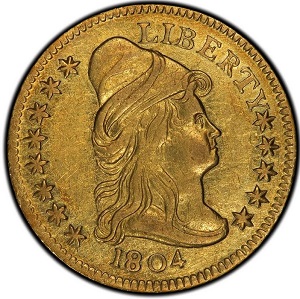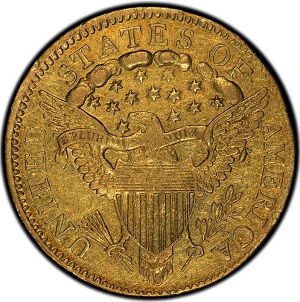1804 Capped Bust $2.50 Quarter Eagle, 13 Star Reverse
United States coin collecting came of age in the 1850s. After the turn of the 20th century the hobby grew more sophisticated, as collecting by variety attracted an audience from among early American copper specialists and other traditional collecting fields.(1)(2)
However, it was to be quite some time before variety collecting gained a foothold among U.S. gold coin experts(3)…
Henry Chapman in 1912 was the first numismatist to document a 13 star reverse variety of the gold 1804 Capped Bust $2.50 quarter eagle, as catalogued in the George Earle Collection. Apparently, no one was impressed, because the lot sold for just $19, well below the $30 realized for 1804 14 star reverse quarter eagle (which we now know to be many times less rare).(4)
Decades later, the 1804 13 star quarter eagle still toiled in anonymity. It wasn’t until the 1960s when the touchstone publication of the hobby, A Guide Book of United States Coins (informally dubbed the Red Book) began listing estimated retail values for this coin.(5)
Things have certainly changed since then. The 1804 Capped Bust 13 Star Reverse quarter eagle today is widely honored as one of the rarest of all quarter eagles and near the top of the highest prizes in United States numismatics.(6)
No one knows how many of the 1804 13 star quarter eagles were struck. Government records suggest a mintage of 1,003 pieces, but with a survivorship of just 11 examples, experts suspect the actual output was probably in the 250-300 range.(7)(8)
Fascinating Fact: Resources were scarce in the early years of the U.S. Mint. Officials took advantage of the fact the silver dime and gold quarter eagle were of nearly identical diameters. The reverse of the 1804 quarter eagle (both 13 and 14 star varieties) was also used for the 1804 dimes, as well as the 1802 quarter eagle.(9)
As an extreme rarity in high demand, the 1804 Capped Bust 13 Star Reverse quarter eagle is practically uncollectible. Even a buyer ready to write out a six-figure check may be out of luck. Normally, we do not include impossible-to-own coins on our Key Date List of recommendations, but because of the educational opportunity this coin presents, it appears here. Who ever heard of cross-denomination die usage?
| Estimated survivors in all grades: 11 ?
The survivor estimate from PCGS represents an average of one or more experts' opinions as to how many examples survive of a particular coin in all grades. Survival estimates include coins that are raw, certified by PCGS, and certified by other grading services. Learn more at PCGS. |
| PCGS Rarity Scale: 9.5 ?
The 'PCGS CoinFacts Rarity Scale' assesses the relative rarity of all U.S. coins, based on estimated surviving examples. The scale runs from 1.0 to 10.0. The higher the number, the rarer the coin.
Learn more at PCGS. |
| Click HERE to check for availability on eBay** |
Preview of eBay selection (you may have to give up on this one on eBay, but never hurts to look):
 |
 |
| Trendline Avg = 11.51 | CLASSIC RARITY |
Historic Value Trend Charts:
| Last updated 7-8-24 | Return to Key Date Coin List | |
| Compare to Common Date Coin of Same Type | ||
|
|
||
| Download Charts to Your Computer | ||
Sources
1. Bowers, Q. David. The History of United States Coinage. Los Angeles, CA: Bowers and Ruddy Galleries, Inc., 1979.
2. Stack's Bowers Galleries. 1804 Capped Bust Right Quarter Eagle. 13 Star Reverse. May 2015 Auction.
3. Stack's Bowers Galleries. 1804 Capped Bust Right Quarter Eagle. 13 Star Reverse. May 2015 Auction.
4. Heritage Auctions. 1804 $2 1/2 13 Star Reverse. Jul 2009 Auction.
5. Stack's Bowers Galleries. 1804 Capped Bust Right Quarter Eagle. 13 Star Reverse. May 2015 Auction.
6. Stack's Bowers Galleries. 1804 Capped Bust Right Quarter Eagle. 13-Star Reverse. Feb 2016 Auction.
7. PCGS. 1804 $2.50 13 Star Reverse (Regular Strike).
8. Heritage Auctions. 1804 $2 1/2 13 Star Reverse. Jul 2009 Auction.
9. Garrett, Jeff and Guth, Ron. 100 Greatest U.S. Coins, 5th ed. Pelham, AL: Whitman Publishing, 2019.
**Many very fine coin dealers sell on eBay. At any point in time, there may be over one million search results for United States coins. This includes quite a few of the recommendations on our Key Date Coin List.
If you’re thinking about purchasing a rare coin, eBay is certainly worth a look. For your convenience, the links from this site to eBay are coded to bring up only coins certified by PCGS and NGC.
As is always, always the case, never buy a valuable coin from a seller whose trustworthiness cannot be verified. Learn more about this at our chapter Best Places to Buy Coins, which also has a section on doing business on eBay.
In the interest of full disclosure, Rare Coins 101 receives a small commission anytime someone connects to eBay from this site and purchases something.
Coin images by Stack's Bowers Galleries.


